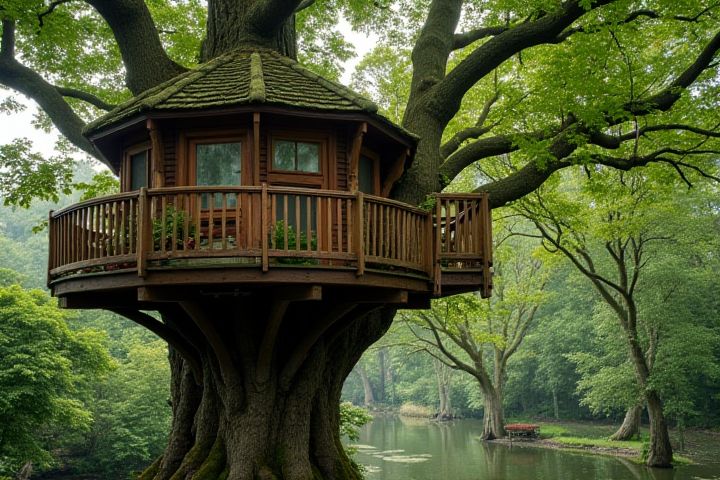
Living in a tree house can be a unique and enchanting experience, blending nature with innovative architecture. Depending on local building regulations and tree health, you can construct a tree house that offers adequate shelter, such as insulated walls and a sturdy roof. Essential amenities, like electricity and running water, can be integrated through appropriate plumbing and wiring solutions. If you value sustainability, consider utilizing eco-friendly materials and designs that minimize environmental impact. Embracing the tranquility of the outdoors, you might find that a tree house provides not only a home but also a sanctuary away from urban life.
Can You Live In A Tree House
Building Permits
Building tree houses involves navigating various zoning laws and building permits, which can vary significantly by location. For residential areas, you typically need to secure a building permit if the tree house exceeds 100 square feet or includes electrical wiring. It's essential to consult with your local zoning office to understand setback requirements and safety regulations, as some municipalities may have specific restrictions on tree house construction. Ensuring compliance with these regulations before starting your project can save you time and potential legal issues down the line.
Safety Regulations
Living in a tree house can be an exhilarating experience, but it requires meticulous adherence to safety regulations to ensure your well-being. First, check local building codes, as many municipalities have specific guidelines that govern tree house construction, including height restrictions and materials. Ensure your tree house is securely anchored to healthy trees, using techniques that minimize damage to the trees and maintain their structural integrity. Regular inspections of your tree house for wear and tear, along with secure railings and non-slip steps, are essential to prevent accidents and promote a safe, enjoyable living environment.
Structural Stability
Living in a tree house can be a unique experience, provided that structural stability is prioritized. The design should incorporate durable materials like treated wood and steel reinforcements, allowing the tree house to withstand fluctuating weather conditions. Key factors such as the tree species, size, and health are crucial; hardwoods like oak or maple offer better support. Regular maintenance checks and proper anchoring techniques ensure a safe living environment, providing peace of mind for residents.
Access to Utilities
Living in a tree house can present unique challenges regarding access to utilities. Many tree houses are built at significant heights, making it difficult to connect to essential services such as water, electricity, and sewage. Solar panels can provide a renewable energy source, with most systems ranging from 100 to 400 watts, sufficient to power basic appliances. For water supply, rainwater harvesting systems can be installed, collecting up to 100 gallons per inch of rainfall, which can then be filtered for drinking and daily use, ensuring your tree house remains comfortable and functional.
Local Zoning Laws
Local zoning laws dramatically influence the feasibility of living in a treehouse. These regulations dictate land usage, building codes, and specific construction requirements that vary by location. You must consider factors such as minimum square footage, distance from property lines, and permissible building materials before initiating your project. Consulting your local zoning office will provide crucial information regarding permits, so you can ensure compliance and enjoy your unique living space.
Climate Considerations
Living in a tree house can be an innovative and sustainable lifestyle choice, greatly influenced by climate considerations. Proper insulation and materials, such as reclaimed wood and eco-friendly finishes, help minimize energy consumption and environmental impact. Elevating the structure reduces the risk of flooding and enhances airflow, promoting natural cooling and ventilation. It's essential to select tree species with strong root systems to ensure stability and longevity, benefiting both your living space and local biodiversity.
Environmental Impact
Living in a tree house can significantly reduce your environmental footprint. A well-constructed tree house minimizes land disruption, preserving the surrounding ecosystem and its biodiversity which includes 80% of terrestrial species found in forests. By using sustainable materials like reclaimed wood, you can lower carbon emissions associated with new construction. Furthermore, integrating solar panels can provide renewable energy, allowing you to live off-grid while conserving energy resources effectively.
Seasonal Accessibility
Living in a tree house can be an enchanting experience, but seasonal accessibility is a crucial factor to consider. During spring and summer, tree houses can provide comfortable living conditions, with temperatures typically ranging from 70degF to 85degF, allowing for pleasant outdoor activities. However, in winter months, temperatures may drop below freezing, creating challenges such as snow accumulation on branches and icy pathways, which can complicate access. Ensuring proper insulation and weatherproofing can enhance your comfort and safety, making your tree house a viable dwelling year-round.
Space Limitations
Living in a tree house presents unique space limitations that significantly affect your lifestyle. Typically, these structures are compact, often ranging from 100 to 300 square feet, which can limit your ability to store possessions or accommodate larger furniture. You'll need to maximize vertical space through innovative storage solutions like built-in shelves and multi-functional furniture. Carefully planned layouts can help you create an efficient living environment, but you'll need to embrace minimalism to thrive in such a restricted area.
Insurance Coverage
Living in a tree house can be an adventurous lifestyle choice, but it poses unique insurance considerations. Homeowners insurance may not cover a tree house if it's classified as a non-permanent structure; you should check with your insurer about specific policy terms. Typically, tree houses require specialized coverage, which can include liability insurance to protect against accidents on the property. You may also want to consider insuring personal belongings and the structure itself separately, offering peace of mind while you enjoy your elevated dwelling.
